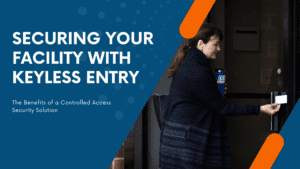Securing Your Facility with Keyless Entry
Keys have been an essential part of our lives for centuries. Many act as a symbol of status and authority, but for others, the mere sight of a key can create anxiety or fear. This is especially true in the workplace, where security is paramount. As technology advances and we become more reliant on it, so does our need to protect this machinery from intruders who could use it against us or even destroy it altogether. Key management systems are one way to prevent these occurrences while also providing secure access control options that ensure only authorized people can enter your facility and steal sensitive information or equipment.
Securing Your Facility with Keyless Entry
Keyless entry, also known as access control, is a great way to secure your facility. Keyless entry, or controlled access, systems can be used in many ways to reduce costs and improve efficiency and security.
For example, keyless door locks can be an alternative to regular mechanical locks with keys. Instead of a traditional key, controlled access doors can be opened with RFID or HID cards, pin or key codes, or even biometrics such as finger or handprints and facial recognition.
The History of Keyless Entry
Keyless entry is a relatively new technology, but it has existed for over 100 years. In 1888, Linus Yale Jr., a locksmith from the United States, invented and patented the first keyless door lock. The lock did not require keys or any other special tools; it just needed your hands to open it.
Today, all types of businesses use controlled access entry systems in their facilities because they provide convenience for employees and customers.
The Benefits of Key Management Systems
Key management systems are a great way to manage your business’s physical security, and the benefits they provide are numerous:
- You can control access to your facility. With traditional keys, there’s no way to know who has them or when they’re used; if someone has a copy of your key, they may use it at any time without you knowing about it until something goes wrong. Keyless entry systems allow you to track who has access and when they are granted access (and from where). You’ll never again be surprised by an unauthorized guest!
- You can control when and how people enter your facility. With controlled access door locks, each person is assigned or denied access to doors. This allows you to control who has access to certain areas of your business and helps secure secure areas.
- The most obvious benefit is convenience—you don’t have to worry about lost or stolen keys. With traditional locks, if a key is lost or stolen, the lock has to be rekeyed or replaced. With keyless entry, you deactivate the card or code and issue a new one. It is faster, cheaper, and more convenient than traditional locks.
- Access Control also provides a significant level of security for facilities with employees who work late at night or early in the morning. Knowing that the facility is only open to those who should have access allows employees to feel safe when they need to work at night or early in the morning.
Conclusion
Keyless entry is a great way to get back control of access to your facility. You can be assured that only authorized people are entering, and there’s no need for costly keys or replacing locks. MCC has been a leading dealer and installer of controlled access solutions for 50 years. To learn more about how MCC can help secure your business, speak with an expert today.





One Response